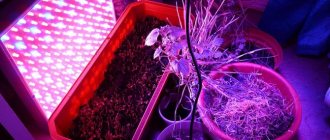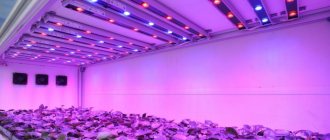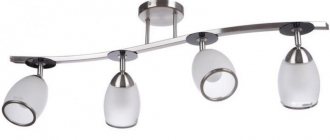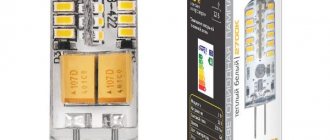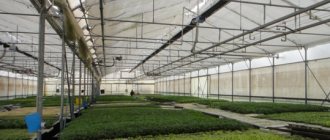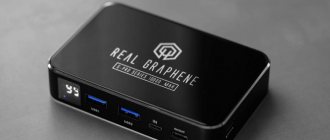Recently, in the field of indoor gardening, there has been an increasing interest in LED lamps for growboxes and LED lamps. Diodes have low power consumption, do not heat up as much as HPS, and do not require additional devices for connection. In this article we will try to understand the pros and cons of this type of lamps and understand where and what the benefits are for the gardener.
LED (Light Emitting Diode)
is a semiconductor device that distorts electrical voltage into light. The spectral range of emitted light depends on the chemical composition of the semiconductor. In appearance, this is almost an ordinary lamp with many LEDs in it. These things were invented back in 1907, but they were developed relatively recently for the needs of crop production. Despite the fact that LED lamps for plants have just entered our lives, they have already managed to create a good reputation for themselves.
How to choose LED lighting for a growbox?
Not all LED lamps are suitable for lighting plants indoors. When choosing, it is necessary to take into account the optical wavelength or, in other words, the range of the emission spectrum
. There is a direct connection between the efficiency of photosynthesis, the amount of rays received by the plant and their spectral composition. Most favorable for plants:
- blue spectrum 430–455 nm, used for lighting during the growing season (the blue-violet range helps in the creation of growth inhibitors that promote plant formation, increasing its density and strength);
- red spectrum 660 nm, used at the flowering stage of plants (the red-orange wavelength range is responsible for the development of fruits, roots, and growth of tops volume).
The remaining ranges are much less effective for backlighting.
Different types of plants, as well as stages of their growth, require different ratios of the blue and red components of the spectrum. Therefore, when choosing an LED panel or lamp, it is necessary to take into account the emission spectrum. It is better to choose multispectral LED lamps, otherwise you will have to buy one unit for the vegetative stage of plant development and a second one for flowering.
The second important characteristic when choosing an LED is power
. It must be selected based on the required lighting area. Let's look at the common types of LED devices and their characteristics:
- Phytolamps with a power of 5-15 W are well suited for illuminating one or two plants, illuminating an area of up to 0.5 square meters; Phytolamps with a power of 21-27 W – cover an area of up to 0.6-0.65 square meters with light.
- A round LED phytolight with a power of 80-150 W is perfect for additional lighting of plants.
- Rectangular LED lights with a power from 150 W to 800 W are the best solution for fully illuminating plants, without the use of natural light.
- Phyto tapes are a solution that offers an advantageous combination of price and quality and is suitable only for supplementary lighting of plants; they cannot replace natural lighting.
Suspension height
Depending on the proximity of the lamp to the plant body, the impact of the light flux will deliver both different power and temperature to the phytoflora.
Rice. 4. Light efficiency depending on height
Please note that gas-discharge and LED phytolamps must be located strictly above the shoots, otherwise the plant will be pulled to the side, which may disrupt its shape in the future. In terms of height, installation is carried out at a height of 15 to 55 cm.
Ideally, you should provide adjustable hanging height:
- Seedlings are illuminated from a minimum height - within 15 - 25 cm;
Rice. 5. Hanging height for seedlings
- during the growing process, when the crown, shoots and leaves of the plant rise above the coverage area, the lamp will need to be raised by 30 - 45 cm so that the entire crop is properly illuminated;
Rice. 6. As they grow, the lamp is raised
- After achieving normal growth, for tall and spreading plants, you can raise the lamp by 45 - 55 cm.
For large crops, the hanging height can be 1 m or more, but this method is justified for greenhouses and greenhouses. The design features of the shelves or ceiling do not always allow the lamp to be raised or lowered. In such situations, you can use special lenses that disperse or focus the flow from the source to a certain angle.
Rice. 7. Selecting the scattering angle
In addition, you can get out of the situation by installing a linear rather than a spotlight.
Advantages of LED plant lighting
- LED panels and phytolights are excellent for home greenhouses, winter gardens, and grow tents, as they emit significantly less heat (compared to HPS). Therefore, when using them, you do not need a separate fan to remove hot air, as with sodium lamps. The optimal height of the suspension is 30-50 cm from the upper leaves of the plant.
- LED lamps do not require additional devices, such as ballasts and ISUs, which are necessary to connect sodium lamps. LED panels and lamps are connected with a standard wire directly to a 220V network, thanks to which the risk of fire or short circuit practically disappears.
- Due to its design, the LED produces a strictly directed beam of light and does not require a reflector.
- LED lamps consume 4-5 times less electricity than sodium lamps. The power consumption declared by the manufacturer will actually be even lower, since it only indicates the size of the crystal and its potential, and less current is supplied. For example, the actual power consumption of a 15 W lamp = 8.5 W.
- Long service life - up to 50,000 hours. Provided that the lamp or lamp you choose will not overheat and burn out.
- Quick installation.
- Does not require constant monitoring and preliminary preparation of the area for placement.
- LED plant lighting is harmless to humans and the environment - it does not contain mercury or other hazardous substances.
Calculation of required power
Let us immediately note that depending on the type of lamp, different power will provide different luminous flux. The easiest way to test power is by visible area coverage and temperature testing at plant level. To do this, turn on the lighting device and check that all leaves are within its coverage area. By placing your hand, you can check whether the plant is heating up beyond normal.
In terms of technical characteristics, LED devices are most often used, for which the following table of power and coverage area is displayed:
Table: power selection by area and distance
| Real lamp power | Distance to plants | Area coverage (diameter) |
| 7-10 W | 20-30 cm | 25-30 cm |
| 10-15 W | 35-40 cm | 45-50 cm |
| 15-20 W | 40-45 cm | 85-90 cm |
In addition, it is important to consider the type of plant for which the lamp is selected, for some crops:
| Name | With natural lighting, W/m2 | Without natural light, W/m2 |
| Large tomato | 100 | 200 |
| Cherry tomato | 100 | 180 |
| Pepper | 100 | 180 |
| Cucumber | 100 | 170 |
| Root vegetable | 50 | 100 |
| Onion | 50 | 100 |
| Parsley | 50 | 80 |
| Berries | 150 | 200 |
| Orchids | 100 | 150 |
Disadvantages of LED
The main limiting factor in the spread of this type of lighting is price. Let's compare the cost of the LED Apollo 4 lamp (power 140 W, lighting area about 60*60 cm) and the HPS 250 W kit (Super HPS lamp 250 W + EMP 1-K-250 W + indoor lamp CoolMaster 100 + fan GARDEN HIGHPRO 160). LED Apollo 4 costs 15,600 rubles, the DNAT kit costs 11,700 rubles.
Well, if you purchase separate blocks of LEDs for the vegetative stage and for flowering, then, ultimately, this will lead to an even greater increase in the cost of the lighting system.
The second common problem with LEDs is overheating and, as a result, burnout. Therefore, it is better to choose a lamp with active cooling. These include Apollo phytolights, which we will discuss further.
It is better not to save money on purchasing LED lamps. Choose LEDs with a guarantee, from reliable manufacturers, read reviews. As a rule, cheap Chinese LEDs quickly fail, and they are difficult to repair, since few people do this.
Comparison of the TOP 9 best phytolamps
Next, as an example, let’s look at the highest quality and most popular lamps for growing plants:
- Espada Fito LED E14-3W - distinguished by three units of LEDs, two of which emit a red glow, and one blue. Excellent for growing and illuminating seedlings. It has a working height from 20 to 100 cm and a dispersion angle of 60°.
- NAVIGATOR 61 202 NLL-FITO – also works in a mixed range, suitable for growing particularly finicky crops. The dispersion angle is 260°.
- Uniel LED-A60-9W/SP/E27/CL ALM01WH – produces a mixed pinkish color, dispersion covers an angle of 160°. Suitable for plants and only emerging shoots.
- Spring 6 W – designed for growing seedlings, but equipped with open LEDs, can be installed close to the leaves, but not recommended above 30cm.
- Helios 15 - consists of 26 LEDs with orange, blue, infrared and ultraviolet light, used as an additional source for any type of vegetation.
- Camelion LED15-PL/BIO – has a mixed flow and is used for primary and additional lighting of indoor plants, gardens, etc. The lamp dispersion angle is 120°.
- AZZWAY PPG T8I-600 – has a matrix of red and blue LEDs; due to its design features, the lamp can be used even in public places.
- Chiston-S – has a narrowly targeted effect on the plant – only 35°, the number of LEDs is 72, and also produces a mixed flow.
- Flora Lamps is a full spectrum lamp with 36 LEDs in red, blue, white, warm, ultraviolet and infrared shades. Produces a dispersion angle of 120°.
LED lamps Apollo
Apollo is a multi-spectral full-fledged luminaire that provides illumination for plants throughout their entire life cycle. The diodes in Apollo lamps operate in five spectra. Color of diodes per segment (nm*pcs): 660*3, 630*6, 470*3, 595*1, 6500*2. According to the manufacturer itself, the Apollo 4 lamp works with the same performance as a 420 W HPS lamp.
Well, to top it off, we publish a spectrogram of the Apollo 140 lamp, 150 W and 250 W HPS lamps.
As you can see, the peak in the blue region of LED Apollo 140 is much higher, which will have a beneficial effect on the vegetative development of the plant. LED Apollo 140 has a clearly defined peak in the red region, while for 150 and 250 HPS it is shifted closer to the yellow spectrum, which is less effective for plant development. The PAR (total photosynthetically active radiation) indicator for the LED Apollo 140 and the 250 W HPS lamp is generally comparable - 161 versus 172.
Conclusion: with the same absorbed watts, the LED Apollo lamp produces more “useful” lighting than HPS 150 and 250 W.
Consider the radiator area
The radiator is an aluminum housing, which in base lamps is located in a circle or, if it is a linear lamp, the entire housing is the radiator. In Figure 3, the radiator is indicated by arrows.
Figure 3
The heatsink is designed to disperse the heat produced by the diodes. Therefore, the volume of the radiator must be designed for the number of diodes so that they do not overheat. The maximum temperature on the diode crystal should not exceed 70-75°C, otherwise they will “degrade”. That is, if there are many diodes in a lamp and the radiator is small, such a lamp will quickly fail.
Figure 4
In order for the LED phytolamp to work properly, the ratio between the radiator area and the number of diodes must be well adjusted. The distance between the diodes is equally important, that is, if there is enough space between the diodes, the heat is distributed faster. An example of the correct “fitting” of diodes on a radiator is shown in Figure 4.
You can find out detailed information about LED phytolamps from the following video:
Hybrid lighting – LED + HPS
When growing highly productive plant hybrids, the combination of HPS + LED can provide a significant increase in yield. Let's take a closer look.
So. HPS lamps with a power of 400 W and higher provide a powerful stream of red light, which is so important for flowering and fruiting. In addition, DNAT is much more multispectral than red-blue diode lamps. LED, on the other hand, emits a minimum of heat - the working surface of a 280W LED lamp barely reaches 40 degrees compared to 200 degrees of HPS, and this is a huge advantage. Thus, if you use a powerful flow of HPS and illuminate the sides with LED panels, then the HPS indicators in lumens will increase from 60000-95000 to 100000-160000, without increasing the temperature in the grow room and saving energy!
At the moment, in Western grow reports you can increasingly find the following type of lighting: 1 HPS and several LED lamps. The result is something previously unimaginable!
To reinforce the information, watch the video from our YouTube channel:
Consider installing additional lenses
As mentioned earlier, the diodes already have a primary lens and an illumination angle of 120 degrees. But if you hang the lamp too high, less light will reach the plants and it will be more scattered. That is, the light will cover an unusable area. This use is ineffective, but you will have to pay extra for electricity. Installing additional lenses will help solve this problem. They come in 15, 30, 45, 60, 90 degrees. Selecting a lens will make it possible to choose the desired height and maintain the useful lamp power needed by the plants.
③ Goodland phytolamp with clothespin mount and USB power
Rating: 4.9 Price: from 633.10 rub.
up to
RUB 1,723.02
Go to the store The device for illuminating plants with a timer supports 5 brightness adjustment modes and 3 options for adjusting the intensity of the glow. The waterproof class of the phytolamp is IP 66, which allows it not to be turned off during watering.
The device operates on 18 blue (460-465 nm) and 36 red (620-625 nm) LEDs, the illumination range of plants is within a radius of 2-3 meters. Timer setting is available in 3 modes: 4, 8 and 12 hours.
The light bulb is equipped with a clothes-clip mount, a remote control and a USB port that allows you to connect to the mains regardless of the presence of sockets nearby.
Advantages:
- availability of different backlight modes;
- convenient timer for 4, 8 or 12 hours;
- metal clothespin;
- detailed instructions in English.
Flaws:
- no power adapter included.
Different operating modes
Buy on AliExpress.com
Power supply for backlight
Having decided on the power of the tape, we select a power supply for it. Here it is necessary to take into account the characteristic features of LEDs; they require current stabilization, not voltage. Ohm's law will help you calculate the current consumed by the tape: I=U/P, where U is the supply voltage of the tape, P is its power. For example, for a lamp consuming 9.6 W, you will need a power supply (12 V) of at least 0.8 A (12/9.6 = 0.8). The cost of such devices is about 100-120 rubles.
Inexpensive 12 V and 1 A power supply
Considering the low cost of power supplies of this class, it makes no sense to make them yourself; for the “ham radio itch” it is better to find a more worthy use.
Making a more powerful current stabilizer with your own hands is also pointless; on the well-known website of Chinese manufacturers, you can purchase such a product, as shown in Figure 8, for only 50 rubles (with free delivery).
Figure 8. 3 A current stabilizer (China)
Please note that the device shown in the figure is a current stabilizer, designed for an input voltage from 3.5 to 35 V (DC), accordingly, it cannot be connected directly to a 220 V outlet. It is first necessary to lower the voltage and convert it from AC to DC, that is, assemble a simple circuit based on a transformer, a diode bridge and a polar capacitor (see Fig. 9).
Figure 9. Schematic of a basic power supply
